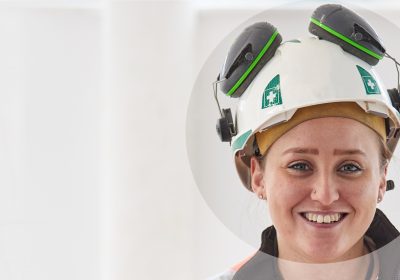Spotlight on… women in construction aims to understand why the gender gap continues to dominate the headlines and suggests steps to tackle the issue...
Examples of best practice
Drawing on pioneering campaigns from within our industry, we’ve complied a resource of best practice and innovative examples. Benefit from the insight and experience of our registered activity, and gain ideas on how you and your organisation can strengthen your approach to this topic.
HRT Prescription Service
This contractor in partnership with Peppy have launched a private online prescription service which is exclusively being used with this contractors employees. Women going through the menopause, when periods stop, have a drop in their natural hormones which can cause symptoms such as low mood, sleeplessness, night sweats, anxiety and joint pain. For some women, these symptoms can be distressing…
Women’s PPE Roadshow
This contractor worked with their suppliers to arrange a ‘try on’ event for the women’s PPE range. This gave female colleagues the opportunity to try out the range on offer in a variety of sizes to ensure a comfortable fit and order what they required on the day. Providing properly fitting, comfortable PPE in women’s sizes, is an important way…
Site Set Up Manual including PPE for Female Workers
With an increasing female workforce, this contractor have included within their site set up manual, PPE available to sites from their partners provider. The provider ensure that ‘Caddick selected’ PPE are in stock for call off when needed. This includes female sizes which are a better fit for the female members of the workforce.
Inclusive PPE in Construction
The Chartered Institute of Building (CIOB), Construction Management Magazine and CIOB People have launched a new campaign to address the lack of inclusive PPE in construction. They brought together a panel of experts to hear their experiences of badly fitting PPE, why it is dangerous and what needs to change. The current shortcomings in PPE provision are nothing new for…
Women in Property Outreach Programme
Women In Property, the contractor and local authority have partnered together to deliver a construction related school outreach programme to a group of 28 pupils at a local high school. The programme comprises of 8 weeks, including an intro to the project followed by sessions from a range of different disciplines in architecture, planning, structural and mechanical engineering, client focus,…
Female Comfort Boxes
After recently carrying out some research into female site welfare standards, one suggestion was to provide ‘comfort boxes’ in the female toilets. Alongside enhancing their minimum standards for toilet facilities following feedback from their employees and visiting clients, they also teamed up with Grace and Green who provide sustainable sanitary solutions that are not only plastic free, but organic and…
Menopause Action Group
This contractor has set-up a Menopause Action Group, recognising that for many people who experience the menopause that it can have huge impacts on their personal and professional lives. The group aims to raise awareness both in work and at home including for men who have partners going through the same. They have implemented specific measures to support their people…
Spotlight on… posters
Spotlight on… posters have been designed for general display in and around site welfare facilities. The Scheme has developed a collection of A3 posters from the series of ‘Spotlight on…’ learning toolkits. This resource has proven valuable for display on site and raising awareness amongst the workforce and visitors. To purchase these products, click here. To download a free electronic…
Residents Women in Construction Bootcamp
Over the past few months this contractor has been working with the Royal Borough of Greenwich and London South East Colleges to set up a women into construction boot camp to provide training and skills to get women from Greenwich Borough into the construction industry. It is being provided in a 4 week programme with recruitment of learners being delivered…
Promoting Women’s Contribution to Construction
This contractor saw an opportunity to promote women in construction through their different projects throughout Ireland and UK. The trend started on their Dungiven to Drumahoe Dualling programme when female staff were offered a ‘Wills Sisters’ jacket to help promote women in construction. This was so successful that the company have now implemented this in their other sites across the…
Combatting Period Poverty
This contractor believe all women should have access to sanitary products during their period however, there are many women who are experiencing period poverty and are unable to access or afford them. These women have no choice but to use rags, socks, or even newspaper to manage their menstruation, making them vulnerable to disease. This project team decided to make…
Breast Feeding Friendly Site
On this site they have pregnant women or mothers present, therefore they have recognised a private space was needed to pump in private to keep up their supply therefore they dedicated a private nursing room for use by the project team and visitors, with a range of appropriate facilities as a minimum standard. The facilities provided include a comfy chair,…
Self Defence for Women’s Safety
Common Sense Self Defence led an informative and action-packed session for all female staff across the project whether site based, working from home or off-site. This was implemented as the final part of the contractors 3-part plan for women’s wellbeing as their team returns to site, which has included focuses on period dignity and domestic violence prevention. The instructor began…
3 Point Plan for Women’s Welfare
This contractor implemented a 3 Point Plan to support women’s wellbeing at work. This plan focused on domestic violence, period dignity and self-defence to create a safer environment both in and out of the workplace. This is especially poignant as domestic abuse reports significantly rose during lockdown & in 2020 it was reported that 55% of women were sexually harassed…
Gender Equality Workshop
To promote sustainable employment, a Women’s Network was established to enable locally recruited women to discuss key issues such as health, gender equality and celebrate International Women’s Day. The local women’s network provides the environment to enable women to not feel alone in a male dominated industry A recent outcome has been the creation of an interactive gender equality workshop…
Wills Sisters
Women make up around 14% of construction industry professionals and this number can only be set to rise with more and more women choosing construction jobs. Misconceptions about gender specific roles are gradually diminishing with the growing number of women choosing a career in construction. This project is promoting a toolbox talk about women in construction. The toolbox talk brings…
Promoting Women in Construction
This project has added posters to their hoarding that celebrates twelve of the most prominent women in construction over the years from the 1500’s to the present day. They hope to have adults and children stop and take the time to read each poster and be inspired to become the next generation of construction workers.
Virtual Work Experience Supporting Women into Construction
The project team recently delivered a virtual work experience session for three women that have shown interest in Construction Health & Safety. Two women came through Women into Construction and one lady through West London College and their three week Sector Skills Academy programme. After initial support given to both stakeholder and their programmes, they were able to provide work…
Personal Safety Conversation Cards
After the tragic murder of Sarah Everard, recent campaigns, vigils, media spotlights, and focus on harassment and violence; this contractor have created a number of new safety conversation starter cards. These have been used as an aid to help open up conversations with the teams regarding personal safety, women’s safety and diversity. By having the conversations, it has made operatives…
‘Hey Girls’ Period Product Packs
Period dignity is essential to health and wellbeing at work. It’s only right that female team members should have menstrual protection provided in every working environment. The Hey Girls Period Dignity campaign is part and parcel of a wider campaign to assist employers, leisure and facility providers to make conditions a little more equal for women at work and play….
Promoting Women in Construction
The project team wanted to actively promote more career opportunities within the construction industry to women. To do this they undertook a series of presentations on construction careers within ‘Salon Services’ in Dover where the site is situated. By partnering with them, they were given access to a female dominated environment that allowed them to explain the roles women can…
Girl Dreamer Academy
The Girl Dreamer Academy programme is an empowerment platform for women and girls of colour. Through leadership development programmes, adventure sport and digital content they aim to build confidence and unleash the potential of girls everywhere. Girl Dreamer likes to push the boundaries, test the waters and go full throttle at everything they do. From setting up the UK’s first…
Presenting the Opportunities Available to Women in Construction
To celebrate International Women’s Day, Kelly Sowden and Sophie Dick hosted a presentation at Temple Moor High School in Leeds to Year 11 students, to promote engineering roles and role for women in engineering. They discussed the different types of engineering and how John Sisk & Son aim to increase the number of women they hire into the industry. Gender…
Brownie Group Visit
Women in the Berkeley St Edward team at Hartland Village, Fleet, visited a local Brownie group (aged 7-10 yrs) to talk about the project and the huge variety of careers in construction. We played a game which involved busting lots of myths about the industry and made sure that they knew it wasn’t just for boys! The group have recently…
Women into Construction
Berkeley West Thames, West London College (WLC) and Women Into Construction (WIC) teamed up this summer to offer women an opportunity to kick start a career in construction by hosting a four week training programme at the West London Construction Academy (WLCA), located on Berkeley’s Southall Waterside development. The programme provided an insight into the vast career options available within…
Championing Back to Work Mums Scheme
We have launched a ‘Championing Back to Work Mums’ scheme with the aim of attracting more women to return to work and get involved in the industry after having children. As a company we value women in our industry and we are committed to respect, treat fairly, encourage and support women within our company. As an incentive, we have introduced…
Plastics and Packaging Actions: Creating Bird Feeders
GRAHAM-BAM Healthcare Partnership recently hosted 14 girls aged 10–13 from the Women’s Tec Summer Scheme GIRLTEC Academy to raise awareness of environmental considerations in construction projects. The workshop formed part of a practical visit to the GBHP Royal Victoria Hospital site to encourage female pupils to consider future careers in construction. The visit included talks and hands on activities from…
Female Specific PPE
After a gap in the market was discovered, our Senior Office Manager, supported by Multiplex’s Temporary Works Manager, have been working with Onsite Support and Leo to develop a dual-tone female-shaped Hi-Vis. The Broadway will be the first project for Multiplex to make this change. Ensuring details of purchasing are passed onto the supply chain, all of the women currently…
Gender Equality Video
The construction industry lacks diversity. There are various diversity issues within the industry and there have been various attempts to tackle the issue. Gender disparity has been one of the diversity issues, as the construction industry is still predominantly male dominated. Changes take time, especially attitude changes. The unconscious biases exist in the industry and the changes in construction industry…
The Madison Workforce Development Hub
A secure iPad in the canteen has been installed for the workforce to access while on their breaks. The iPad stand is adjustable and has two positions, so the user can stand up or sit down. The stool provided at the station is made out of re-used waste materials from site. The iPad is preloaded with information on the following…
Providing ‘Period Dignity’ within the Construction Industry
Over the past few years, the construction industry has been trying to improve the diversity of the workforce by encouraging more women into the industry. However, as the industry is still fairly male orientated, there is still a risk that welfare facilities and toilets may not be suitable for female members of staff (for example there may not be clean/…
Giant Tetrahedron Challenge
Construction has an infamous gender imbalance which the industry needs to redress. Working with young women can help tackle false perceptions of the industry and promote construction careers. See the examples below for how one site addressed this: The site supported the local council’s Women in Engineering and STEM event for secondary school aged females. The site team delivered a…
On Site Skills Zone
As part of BAM Construction’s Ready, Steady, Girls Construct! Employability programme, the Blairdardie Primary School site team created an onsite skills zone to host the group. The programme, which focuses on attracting female pupils into the construction industry by providing them with industry insight, training, work experience and employability skills, was delivered over a 10 week period to a group…
Animated Video Promoting Women in Construction
Women remain vastly underrepresented in the construction industry. I started as a graduate in Redrow Homes and they have a robust plan in place to encourage and support women. Redrow decided to make an animation video where I was able to tell my story, stating a message that construction is a great place to work and many people were able…
Girls’ horizons broadened through female-only STEM Campaign
As part of Heron Bros project delivery for East Renfrewshire Council and the construction of Faith Schools Joint Campus, Crookfur PS & Nursery and Arthurlie Family Centre, they implemented the “Girls’ Horizons” Initiative to encourage females into STEM careers. In partnership with East Renfrewshire Council, BDP Architects and local schools a female-only careers event was held. More than 80 pupils…
Promoting Women in Construction
As part of our commitment to promoting women in construction, the Interserve site team at our flagship £25M Leisure Centre project in Eastleigh, Hampshire have hosted two Women in Property breakfast meetings which have included presentations about the design and construction challenges faced as well as a site tour for those attending. The project has a number of women working…
International Women in Engineering Day
International Women in Engineering Day is an annual event organised by the Women’s Engineering Society to promote career opportunities and celebrate successful female engineers. To celebrate this day on your site you could consider: Attending and presenting at a Women in Engineering event. Conducting a visit to a local school to promote engineering careers to young women and men. Encourage…
Female PPE Initiative
Women who work for BAM Nuttall are being supplied with workwear designed specifically for them. After a series of trials on a number of its sites in London, Leeds, Newcastle and Scotland, the company is rolling out a range of work clothing nationwide that is specifically designed for women. Working with workwear manufacturer Arco, BAM Nuttall has commissioned polo shirts,…
Encouraging Women into Construction
Reports reveal that women are expected to make up a quarter (26%) of the UK’s construction workforce by 2020. Although companies are doing more to encourage women to join the industry, 41% of women still believe men are paid more. Encouraging and retaining more women in construction is essential to filling the looming skills shortage. Ballymore is encouraging women to…
Inspiring Women in our Industry
To celebrate International Women in Engineering Day, we developed a series of short bios of women in our business. Drawing from a broad cross section of disciplines and experience from within the project, our leadership team worked with women to capture and celebrate their own journey in engineering and construction. As well as capturing their stories, we encouraged our women…
Inspiring Girls into Construction
Pupils from four schools in East Renfrewshire recently attended an informative workshop hosted by BAM Construction. Held at Barrhead High School, a live construction site, the event was designed to inspire girls to consider construction as a career. Third to fifth year pupils were selected to take part from Williamwood High School, St Ninians, Woodfarm High School and St Luke’s…
Offering Work Placements for Women into Construction Members
As part of a greater effort to introduce new talent into the industry, Crossrail Paddington offered short term work placements and CV Workshops to members of Women into Construction (WiC), giving them the opportunity to develop their skills and gain further project experience. Aliona supported the commercial team as an assistant to help produce subcontract agreement for various work packages;…
International Women’s Day
International Women’s Day is a global day celebrating the social, economic, cultural and political achievements of women. To support International Women’s Day on your site, you could do the following: Support and participate in ‘Women in Construction’ events; Have a robust equality and diversity policy ensuring men and women are treated equally; Visit the ‘International Women’s Day’ website to view resources…
Mace’s ‘Building Futures’ programme
One of the problems that exists when talking to young people about careers in construction is the lack of understanding about the variety of different roles available. Both teachers and school children are unaware of the scope with a career in construction and can limit the options of students because of preconceptions about who would be suitable to work in…
Celebrating National Women in Engineering Day
To celebrate women in engineering and support and encourage more women to consider a career in engineering or construction, we developed a series of activities to celebrate National Women in Engineering Day (NWED). These encouraged staff to take the opportunity to understand a bit more about how the role of women in engineering has changed and continues to change in…
CITB’s Be Fair Framework
A key requirement of the Scheme’s Code of Considerate Practice is to provide a workplace where everyone is respected, treated fairly, encouraged, supported and made to feel valued as an employee. All members of the workforce must be treated fairly and without discrimination. An ‘inclusion’ policy should demonstrate commitment to equality, diversity and respect amongst the workforce. Many companies are turning to CITB’s…


















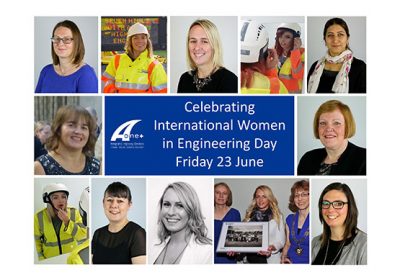




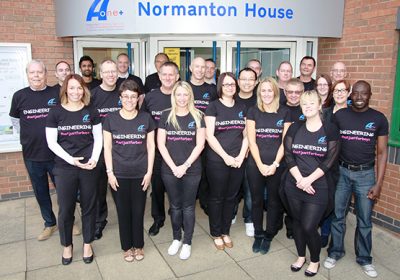

 Aby Wallace is Site Manager at Robertson. Aby completed a Construction Management qualification at University, and since graduating has progressed to being a site manager.
Aby Wallace is Site Manager at Robertson. Aby completed a Construction Management qualification at University, and since graduating has progressed to being a site manager.
 Aoife Healy is the Community Liaison Officer for JJ Rhatigan. Aoife has been in the construction industry for three years and works on all JJ Rhatigan projects across London, spearheading community engagement and the Considerate Constructors Scheme.
Aoife Healy is the Community Liaison Officer for JJ Rhatigan. Aoife has been in the construction industry for three years and works on all JJ Rhatigan projects across London, spearheading community engagement and the Considerate Constructors Scheme.
 Caroline Barker is a civil engineer by profession and a Monitor for the Considerate Constructors Scheme. She is actively involved in the effort to improve the image of the industry and encourage people from diverse backgrounds to consider a career in construction. Read her case study
Caroline Barker is a civil engineer by profession and a Monitor for the Considerate Constructors Scheme. She is actively involved in the effort to improve the image of the industry and encourage people from diverse backgrounds to consider a career in construction. Read her case study  Claudia Carroll is a site engineer for Danaher and Walsh. Claudia has been in the industry since August 2020 having graduated from Loughborough University. She is currently working on a project involving the construction of two new road bridges in central Leicester. Read her case study
Claudia Carroll is a site engineer for Danaher and Walsh. Claudia has been in the industry since August 2020 having graduated from Loughborough University. She is currently working on a project involving the construction of two new road bridges in central Leicester. Read her case study  Eillish Kwai is the Employment and Skills Manager at Ardmore. She is actively involved with the Women into Construction organisation, providing women with advice, training and job opportunities in the industry. Read her case study
Eillish Kwai is the Employment and Skills Manager at Ardmore. She is actively involved with the Women into Construction organisation, providing women with advice, training and job opportunities in the industry. Read her case study  Hayley Gill is Site Manager at Robertson Construction. Hayley did work experience on a site at 15 and is now attending College to gain qualifications in Construction Management.
Hayley Gill is Site Manager at Robertson Construction. Hayley did work experience on a site at 15 and is now attending College to gain qualifications in Construction Management.
 Kath Moore is a qualified carpenter by trade and the Managing Director of Women into Construction, a not-for-profit organisation supporting women wishing to work in the construction industry.
Kath Moore is a qualified carpenter by trade and the Managing Director of Women into Construction, a not-for-profit organisation supporting women wishing to work in the construction industry.
 Jo Bowditch is a Monitor with the Considerate Constructors Scheme. As a Monitor, Jo gets to visit construction projects of all types and interact with the people working in the industry.
Jo Bowditch is a Monitor with the Considerate Constructors Scheme. As a Monitor, Jo gets to visit construction projects of all types and interact with the people working in the industry.
 Katie Kelleher is a crawler crane operator working for Select/Laing O’Rourke. Katie worked in recruitment before starting an apprenticeship in October 2014. She has been working on the Tottenham Court Road Crossrail site since May 2015. Read her case study
Katie Kelleher is a crawler crane operator working for Select/Laing O’Rourke. Katie worked in recruitment before starting an apprenticeship in October 2014. She has been working on the Tottenham Court Road Crossrail site since May 2015. Read her case study  Laura Doherty is Site Manager at Robertson Construction. Laura has worked in the industry since she left school and has worked in Civil Engineering, Utilities and House Building.
Laura Doherty is Site Manager at Robertson Construction. Laura has worked in the industry since she left school and has worked in Civil Engineering, Utilities and House Building.
 Leanne O’Donovan is an Assistant Site Manager at L&Q. Leanne carried out work experience at L&Q, fell in love with the industry and has worked in it ever since.
Leanne O’Donovan is an Assistant Site Manager at L&Q. Leanne carried out work experience at L&Q, fell in love with the industry and has worked in it ever since.
 Liz Moss is an Apprentice Site Manager at Morgan Sindall. Liz completed her Extended Level 3 Diploma in Construction and the Built Environment and was encouraged to explore work experience and apprenticeship opportunities.
Liz Moss is an Apprentice Site Manager at Morgan Sindall. Liz completed her Extended Level 3 Diploma in Construction and the Built Environment and was encouraged to explore work experience and apprenticeship opportunities.
 Lynette Whittle is a Monitor with the Considerate Constructors Scheme. As a Monitor, Lynette gets to visit construction projects of all types and interact with the people working in the industry.
Lynette Whittle is a Monitor with the Considerate Constructors Scheme. As a Monitor, Lynette gets to visit construction projects of all types and interact with the people working in the industry.
 Margaret Conway is a Project Manager for McAleer & Rushe. In 2017 she became the first woman to win the Construction Manager of the Year Award for her work on the 9 Adelaide project in Belfast. Read her case study
Margaret Conway is a Project Manager for McAleer & Rushe. In 2017 she became the first woman to win the Construction Manager of the Year Award for her work on the 9 Adelaide project in Belfast. Read her case study  Megan Robinson is a Technical Coordinator at Barratt Developments plc and co-founder of Built by Both, a campaign to inspire young women to embark on careers in the built environment. Read her case study
Megan Robinson is a Technical Coordinator at Barratt Developments plc and co-founder of Built by Both, a campaign to inspire young women to embark on careers in the built environment. Read her case study  Michèle Dix is Managing Director of Crossrail 2, a new railway which will improve access to and from London and reduce congestion on existing rail services. Before moving to Crossrail, Michèle worked as Director of Congestion Charging at Transport for London. Read her case study
Michèle Dix is Managing Director of Crossrail 2, a new railway which will improve access to and from London and reduce congestion on existing rail services. Before moving to Crossrail, Michèle worked as Director of Congestion Charging at Transport for London. Read her case study  Mollie Phipps is an Intermediate Quantity Surveyor, at Watson & Cox Construction. Mollie was interested in Architecture from the age of 6, and has completed many qualifications to reach her current role.
Mollie Phipps is an Intermediate Quantity Surveyor, at Watson & Cox Construction. Mollie was interested in Architecture from the age of 6, and has completed many qualifications to reach her current role.
 Nayera Aslam is Aviation Engineering Manager for AECOM. Nayera was interested in an engineering career by technical feats like the Channel Tunnel and the Hoover Dam and has since worked on projects including the London 2012 Olympics. Read her case study
Nayera Aslam is Aviation Engineering Manager for AECOM. Nayera was interested in an engineering career by technical feats like the Channel Tunnel and the Hoover Dam and has since worked on projects including the London 2012 Olympics. Read her case study  Nicola Jackson is a Technical Manager at Robertson. When Nicola was 14 she gained work experience at an architecture firm and from this point decided this was the career path for her.
Nicola Jackson is a Technical Manager at Robertson. When Nicola was 14 she gained work experience at an architecture firm and from this point decided this was the career path for her.
 Noelene Russell is an Architectural Assistant at Claridge Architects. She was attracted to architecture by its artistic nature and is currently working on a large development project in Plymouth. Read her case study
Noelene Russell is an Architectural Assistant at Claridge Architects. She was attracted to architecture by its artistic nature and is currently working on a large development project in Plymouth. Read her case study  Roma Agrawal is a Structural Engineer at AECOM. Throughout her career she has worked on major projects, including The Shard, and appeared on television and radio promoting engineering careers to young people. Read her case study
Roma Agrawal is a Structural Engineer at AECOM. Throughout her career she has worked on major projects, including The Shard, and appeared on television and radio promoting engineering careers to young people. Read her case study  Ruby Lee is a Trainee Site Manager with Berkeley Homes. She had never considered a construction career until attending a careers event where Berkeley were present. She has been working on the Kidbrooke Village site since September 2017. Read her case study
Ruby Lee is a Trainee Site Manager with Berkeley Homes. She had never considered a construction career until attending a careers event where Berkeley were present. She has been working on the Kidbrooke Village site since September 2017. Read her case study 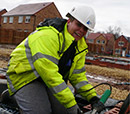 Sally Cave is the first qualified female Gas Membrane Installer in the UK. She began working at her father’s installation company in administration but trained to become qualified for on-site work. Read her case study
Sally Cave is the first qualified female Gas Membrane Installer in the UK. She began working at her father’s installation company in administration but trained to become qualified for on-site work. Read her case study  Savannah Williams-Duberry is an Architectural Assistant Apprentice at L&Q. Savannah wanted to gain knowledge of buildings and properties, which led her to architecture.
Savannah Williams-Duberry is an Architectural Assistant Apprentice at L&Q. Savannah wanted to gain knowledge of buildings and properties, which led her to architecture.
 Shannon Dawe is a Community Impact Advisor at Robertson. Shannon’s role is centred around planning, delivering, and reporting on social value within the communities they work.
Shannon Dawe is a Community Impact Advisor at Robertson. Shannon’s role is centred around planning, delivering, and reporting on social value within the communities they work.
 Stephanie Bennett is a trainee Quantity Surveyor with Morgan Sindall. She worked in administration before becoming a surveyor and is currently being supported through university by Morgan Sindall. Read her case study
Stephanie Bennett is a trainee Quantity Surveyor with Morgan Sindall. She worked in administration before becoming a surveyor and is currently being supported through university by Morgan Sindall. Read her case study 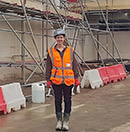 Victoria Betts is a senior Site Manager at Higgins Construction working on the Gabriel Square project in St. Albans. She started in the industry working with her father for a general building company carrying out plastering, tiling and kitchen installation. Read her case study
Victoria Betts is a senior Site Manager at Higgins Construction working on the Gabriel Square project in St. Albans. She started in the industry working with her father for a general building company carrying out plastering, tiling and kitchen installation. Read her case study  Yosra Khalaf is a Site Manager at Peabody. Yosra studied Civil Engineering at University before moving to the UK and working her way up to becoming a Site Manager.
Yosra Khalaf is a Site Manager at Peabody. Yosra studied Civil Engineering at University before moving to the UK and working her way up to becoming a Site Manager.




